Essential Guide to Beginner Kiteboarding Kites
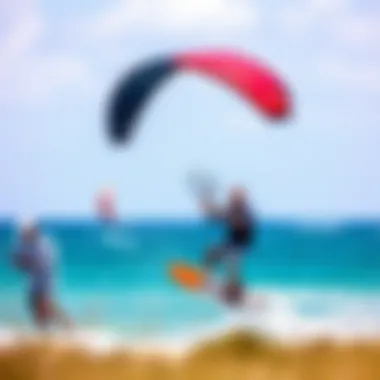
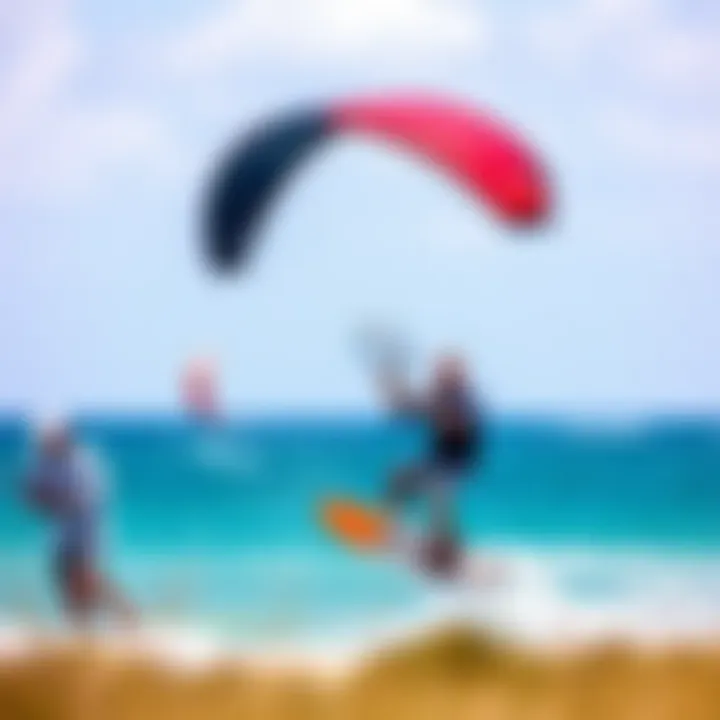
Intro
Kiteboarding, often called kitesurfing, is an exhilarating sport that combines surfing and paragliding. For a beginner, the first step into this captivating world is to understand the essential gear, particularly the kites used to harness the wind's power. Right off the bat, one must realize that kite selection is paramount for a successful experience on the water.
While it might be tempting to just grab any kite off the shelf, or go for the flashiest design, this choice must be informed and deliberate. Not only is the type of kite important, but also understanding how various elements interact with the environment is crucial. Newbies can easily feel overwhelmed, but this guide aims to simplify the process by breaking down the key aspects of kiteboarding kites.
Gear Selection
When it comes to choosing gear for kiteboarding, two fundamental components stand out: the kites themselves and the boards that carry you over the waves. Each kite has its own set of characteristics that make it suited for particular riding styles and conditions. If you’re just starting out, knowing these differences could save you a lot of time—and maybe even a few wipeouts.
Types of Kites
The landscape of kiteboarding features several types of kites. Here are the main types you should know:
- LEI (Leading Edge Inflatable): These kites have a rigid leading edge that you inflate with air. LEIs are versatile and stable, great for beginners learning to control their movements on the water.
- Foil Kites: Unlike LEIs, foil kites are self-inflating and made of fabric. They are often lighter and can be advantageous in lighter wind conditions, but they require a bit more finesse to operate.
- C-Kites: These have a distinctive C-shaped design. While they offer impressive performance for advanced riders, beginners may find them challenging due to their limited depower capabilities.
- Delta Kites: These kites are often recommended for beginners due to their forgiving nature. They provide a smooth ride and are generally easier to control compared to C-kites.
When making your selection, keep in mind that wind conditions and your own body weight will play significant roles in finding the right kite size. Smaller kites work well in strong winds, while larger ones are preferable in lighter winds.
Choosing the Right Board
Just as the kite is vital, so is the board. Choosing the wrong board can make even the best kite feel like a lemon. Boards come in various shapes and sizes, and understanding what works best for you will greatly impact your learning curve.
- Twin-Tip Boards: These boards are versatile and reversible, making them perfect for beginners. They allow you to ride in both directions without needing to turn the board around.
- Directional Boards: These boards are designed for riding in one direction, similar to a surfboard. Beginners may find them trickier as they require a different skill set for turning and control.
- Board Size: As a rule of thumb, lighter riders should opt for smaller boards, while heavier individuals may benefit from larger ones. The volume of the board also affects buoyancy and responsiveness in different conditions.
By considering both kite and board, beginners can become well-prepared to make an informed selection that suits their style and skill level.
"Choosing the right equipment not only enhances your performance but also dramatically increases your enjoyment while kiteboarding."
Skill Development
Once you have the right gear in hand, the next step is honing your skills. While practice is essential, there are a few fundamental techniques all beginners ought to grasp. The journey from novice to proficient rider requires patience and commitment, but understanding the foundational skills can accelerate the learning process.
Essential Techniques
- Understanding the Wind: An essential skill in kiteboarding is reading the wind. Understanding how to gauge the wind conditions not only keeps you safe but also elevates your riding experience.
- Kite Control: Learning how to properly manage the kite in the air is crucial. This involves understanding how to steer the kite and manage its power.
- Body Position: Your stance and body positioning on the board will influence your control and balance. Practicing correct posture can make or break your riding experience.
Progression Tips
Progression comes with time and practice. Keep these pointers in mind:
- Start with Lessons: Don’t shy away from professional instructions if you can afford it. Instructors can provide valuable insights that can save you time in learning.
- Practice Regularly: The more time you spend on the water, the quicker you will improve. Make it a goal to practice regularly, even if it means taking shorter sessions.
- Set Achievable Goals: Track your progress by setting small, achievable goals. Whether it be mastering a specific turn or controlling the kite more effectively, little milestones can build confidence.
Ultimately, kiteboarding is about enjoying the ride, and with the proper knowledge in gear and skill development, your journey into the wind and waves can be both safe and rewarding.
As you dive into this thrilling sport, remember that learning is a process—so take it one kiteboard at a time.
Prelude to Kiteboarding
Kiteboarding, a sport that seamlessly merges surfing, sailing, and flying, has captured the hearts of countless enthusiasts around the globe. It’s not just about skimming across water like a bullet; it's about riding the wind, feeling the rush, and harnessing nature's power to glide effortlessly. This article aims to delve into the fascinating world of kiteboarding kites, especially designed for beginners who are taking their first steps into this exhilarating journey.
Embarking on the kiteboarding adventure involves understanding various elements—starting with the kites themselves. Grasping the basics of kiteboarding can significantly elevate the enjoyment and might just keep you out of some tricky situations.
In this guide, we will unpack essential aspects like the different types of kites, their distinctive features, and the safety measures every novice should be aware of. We’ll also discuss what to look for when selecting your first kite, ensuring you have the tools necessary to ride the waves with confidence. This knowledge not only sets the stage for an enjoyable hobby but also helps prevent accidents, particularly for those unfamiliar with the sport.
The Appeal of Kiteboarding
Kiteboarding is often described as one of the most thrill-packed sports, with its dynamic nature and the sheer joy of harnessing wind power to propel oneself across water. Many are drawn to the freedom it offers—the ability to soar over waves, perform tricks, and travel to remote locations that are far from the madding crowd. For many, it’s akin to flying, and that appeal is irresistible.
The community surrounding kiteboarding is another facet of its charm. Whether you are a novice or a pro, the camaraderie among kiteboarders creates a welcoming environment. From the shared excitement of perfect wind conditions to the learning curves experienced at every level, there’s an unspoken bond that connects participants in this sport.
Evolution of Kiteboarding
Kiteboarding didn't just appear out of thin air; it has a rich history that spans several decades. The combination of traditional surfing with kite technology traces back to the late 20th century when innovators began experimenting with different materials and designs. Initially known as kitesurfing, this exciting activity underwent significant transformations, influenced by inventions from various cultures around the world.
By the 1990s, kite design improved dramatically, leading to a surge in popularity as kites became easier to control and more forgiving for beginners. This evolution also saw the introduction of inflatable kites, which enhanced safety and performance. As the sport evolved, so did the passion of riders, leading to competitions, global events, and an ever-increasing list of enthusiasts pushing the boundaries of what’s possible.
"Kiteboarding’s evolution mirrors the relentless human spirit: ever curious, perpetually pushing boundaries."
Understanding the landscape of kiteboarding is essential for beginners; it provides context and insights about buying decisions and training choices that align with the sport's exhilarating nature. As this guide unfolds, readers will gain a clearer understanding of how to approach their kiteboarding journey armed with unique insights and skills.
Understanding Kiteboarding Kites
Kiteboarding kites are the heart and soul of this exhilarating sport. For anyone just stepping into kiteboarding, grasping the basics about kites is imperative. It’s not merely a recreational activity; it’s a blend of profound physics and thrill, and your kite plays a crucial role in how you experience the wind and water. Choosing the right kite directly influences your ability to learn, perform, and even your safety on the water. Thus, understanding what kiteboarding kites are, along with their components, sets the foundation for a safer and enjoyable experience.
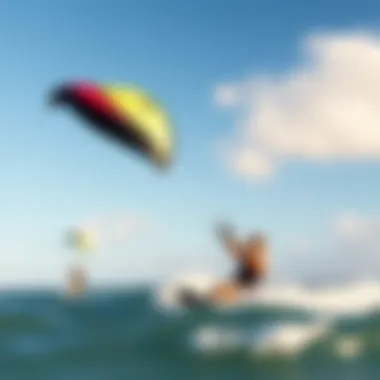
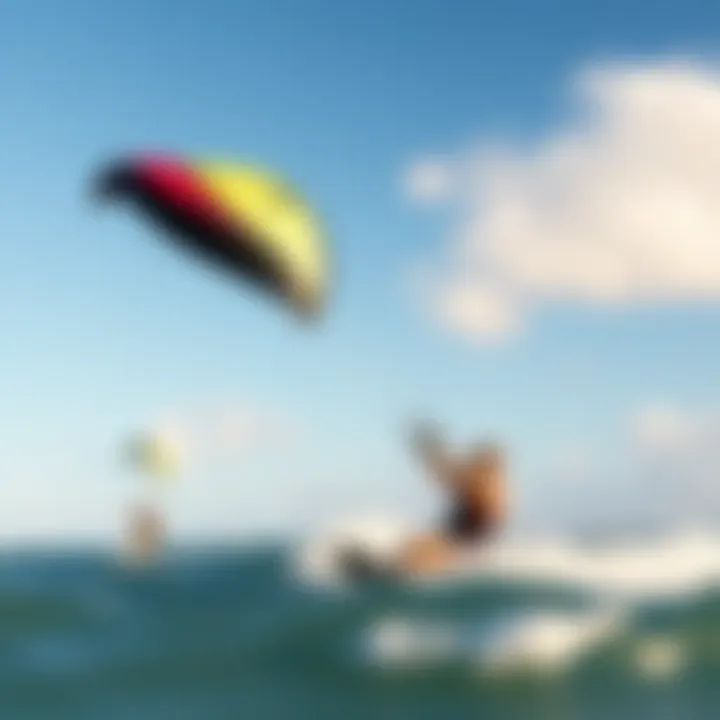
What Are Kiteboarding Kites?
Kiteboarding kites are specially designed inflatable or non-inflatable kites that harness the wind's power, pulling the rider across the water. These kites come in varying sizes and shapes, each suitable for different wind conditions and rider skills. Essentially, they translate wind energy into powerful forward motion, allowing riders to maneuver across waves or even perform aerial tricks. Knowledge about the types and functionalities of kites is a stepping stone toward mastering kiteboarding.
Components of a Kite
To truly understand kiteboarding kites, one must delve into their various components. Each part serves an essential role in the kite’s performance and the rider's experience. Here are the core components:
Leading Edge
The leading edge of a kite is the front part that faces forward as it moves through the air. This aspect is crucial because it helps maintain the kite’s shape and aerodynamics. A well-designed leading edge allows the kite to slice through the wind smoothly, which is vital for stability and lift. In beginner-friendly kites, the leading edge often features a thicker tube for increased rigidity, allowing for better control, even in varying wind conditions.
A sturdy leading edge can significantly reduce the chances of a kite collapsing mid-flight, ensuring a safer ride for newbies.
Canopy
The canopy is the sail part of the kite that catches the wind. Its material and design determine how effectively it can generate lift and how responsive the kite is. For beginners, kites with a larger surface area in the canopy tend to be more forgiving and easier to control, making them an ideal choices. Canopies styled for performance can be lighter but might demand more skill from the rider to handle effectively.
Trails and Struts
Trails and struts provide structural support to the kite, giving it the necessary shape to fly efficiently. These elements determine the kite's stability and responsiveness. Strong, lightweight materials are typically used, allowing the kite to maintain its form in the air. Kites designed with efficient trails and appropriately spaced struts are beneficial because they balance stability and maneuverability, essential elements for learners.
Bridle System
The bridle system connects the kite to the control bar, influencing how the kite behaves in the air. It helps in distributing the forces encountered while flying, affecting the kite's responsiveness and control. Kites with a simplified bridle system are often recommended for beginners as they maximize ease of handling. A user-friendly bridle setup can be the difference between a smooth start and an overly frustrating experience.
In summary, understanding these components not only enhances a beginner's knowledge but also equips them to make knowledgeable decisions regarding kite selection and usage. Each part contributes to the whole, impacting how well the kite performs on the water.
Types of Kites
In the world of kiteboarding, selecting the right type of kite can be a game changer, especially for beginners. Different kites are designed with specific conditions and styles in mind, and understanding these types can make or break the riding experience. Beginners need to realize that not all kites are created equal. Each type brings its own strengths and weaknesses, catering to varied wind conditions, skill levels, and personal preferences. This section dives into the three main types of kites: inflatable kites, foil kites, and hybrid kites. Each of these categories has distinct characteristics that can influence a novice's learning curve and safety.
Inflatable Kites
Inflatable kites are often the go-to choice for many who are just starting out. Designed with air-filled tubes, these kites offer excellent stability and control. One of the biggest perks is their ability to float on water, making them a safer option for learners who may take unexpected dips. Additionally, inflatable kites offer impressive pull and lift, which helps beginners get up on the board more easily. They're often available in a range of sizes, allowing new riders to select a kite that suits their weight, skill level, and the wind conditions they intend to face.
Inflatable kites provide a forgiving nature that helps boost confidence in new kiteboarders.
However, it's worth noting that these kites can be challenging in very high winds, and they may require slightly more maintenance than other types. Newcomers should keep an eye on their kites for wear and tear, especially on the seams and bladders. Regular inspections and prompt repairs are crucial for the longevity of inflatable kites.
Foil Kites
Foil kites, unlike their inflatable counterparts, don't have rigid frames. Instead, they are made up of multiple cells that fill with air when in flight. This unique design offers incredible performance in light wind, making them appealing to riders who frequent lighter air spots. Foil kites are typically lighter and easier to pack, which is an advantage for those looking to travel with their gear.
However, the foiling process often requires more skill to manage correctly, particularly in gusty or strong winds. Beginners might find them a bit tricky to handle since they lack the stability associated with inflatable options. That said, once a rider masters controlling a foil kite, the thrill that comes from flying it in appropriate conditions is unmatched.
It's also crucial for beginners to be mindful of their location. Foil kites may behave differently depending on the terrain; for instance, riding on a hard surface versus a sandy beach will yield different results. Understanding these nuances can lead to a much more enjoyable experience on the water.
Hybrid Kites
In recent years, hybrid kites have emerged as a blend of both inflatable and foil designs. This versatility allows riders to benefit from elements of both worlds. Generally, hybrid kites provide a good balance of power and stability, making them an attractive option for beginners. They can perform well across different wind conditions, making transitions from light to strong winds smoother for new kiteboarders.
Hybrids tend to have a sizable wind range, meaning you don’t have to constantly change kites as the wind conditions shift. However, this flexibility comes with a learning curve. While they may provide enhanced performance, newcomers may need to spend some time getting used to the kite's feedback and handling characteristics.
In summary, when deciding which kite to choose, new kiteboarders should consider their skill development, preferred riding conditions, and how often they plan to hit the water. Understanding these types of kites is a substantial step towards not just enhancing the learning process but also ensuring safety and enjoyment during their time on the water.
Choosing the Right Kite for Beginners
Choosing the right kite is one of the most pivotal decisions a newcomer can make when entering the world of kiteboarding. Every kite is a unique blend of characteristics designed for various conditions and user experiences. For beginners, this choice can significantly influence not just how quickly they learn but also how enjoyable their early experiences will be. A well-suited kite sets the groundwork for mastering the skills needed to take on the water safely and confidently.
Factors to Consider
Skill Level
Skill level is a key factor in selecting the right kite. Beginners often fare better with kites that deliver a forgiving ride. Generally, beginners are encouraged to choose a kite that offers stability and ease of control, allowing them to develop their skills without overwhelming challenges. That's because when you're just getting off the ground, the last thing you want is a kite that acts too snappy or catch you off guard.
“A kite that is too advanced will only lead to frustration and potential accidents.”
When it comes to having a good time while learning, kites designed for beginners tend to be more user-friendly. They provide a comfortable balance between responsiveness and predictability, allowing novices to appreciate the experience without inappropriate risks. A common misconception is that a beginner should pick the smallest kite for easier handling; however, a right-sized kite, typically larger than advanced options, provides necessary lift and stability to get started.
Wind Conditions
Wind conditions play a vital role in determining which kite may be best suited to a beginner's needs. It's crucial to understand that not all wind is the same, and beginner-friendly kites tend to perform well in a variety of conditions, particularly moderate winds. The ideal wind range is usually between 12 to 20 knots for novices. This range allows beginners to practice their skills without the kite becoming too difficult to manage.
Beginners should be aware of the significance of the wind's speed and directions. Kites designed for lighter winds can help novices learn without being pushed around too much. They maintain their predictability even when the breeze is less favorable. Conversely, if conditions are too strong, a beginner kite can become unmanageable, leading to safety concerns. It's important that novice kiteboarders gauge the wind on their chosen day carefully – recognizing that some days are better left for sailing than flying.


Weight and Size
Weight and size can seem trivial, but they’re crucial for a beginner's kite choice. Every kite has a recommended size based on the rider's weight, which influences its performance on the water. The size of the kite dictates how much power it can generate and how well it can hold in varying wind conditions. Getting this right means achieving a balance that lets you learn the ropes effectively and safely.
A kite that is too small for a rider will not generate enough power, making it hard to catch the wind. This could render the kite almost useless and lead to frustrating situations for a novice on the water. On the flip side, a kite that’s too large can lead to uncontrollable force, making for a challenging learning path. Therefore, choosing the correct size kite based on your weight is essential for not only enjoying kiteboarding but also thriving as a beginner.
Recommended Sizes for Beginners
When it comes to sizes, the common recommendation for beginners varies but often falls within a range of 7 to 12 meters depending on the rider's weight and the typical wind conditions of the location. For instance, lighter individuals (around 50-70 kg) might find an 8 to 10 meter kite better suited, whereas heavier people may find a 10 to 12 meter kite works more effectively.
In a nutshell, the beginner's journey can start with confidence when equipped with the right kite, tailored to their unique needs. Taking time to understand the dynamics of skill level, wind conditions, and physical attributes can lead to a smoother and more rewarding kiteboarding experience.
Essential Gear Beyond the Kite
Kiteboarding is not just about the kite; it’s a symphony of various pieces coming together for an exhilarating experience. This section dives into the essential gear every beginner should consider alongside their kite to ensure safety, comfort, and a seamless ride. The right equipment enhances performance and contributes to a much more enjoyable journey into this thrilling water sport.
Control Bars
The control bar acts as the bridge between the kite and the kiteboarder. It’s crucial for steering and controlling the power generated by the kite. With a good control bar, a rider can respond quickly to the changing winds and adapt to the conditions on the water. Here’s what to keep in mind:
- Material and Design: Control bars are typically made from lightweight materials like aluminum or carbon fiber. A well-designed bar can provide better grip, making it easier for beginners to hold on during flight.
- Safety Features: Look for control bars with reliable safety mechanisms. These often include a quick-release system that allows you to detach the kite quickly in case of an emergency.
- Length: Bar length should correlate with the size of the kite. A bar that’s too short or too long can impact control. Most manufacturers provide guidance on pairing kite sizes with bar lengths.
Harnesses
Harnesses are essential gear that connects the rider to the kite via the control bar. They distribute the pull of the kite over the body, which is pivotal when it comes to endurance on the water. Here’s what to consider:
- Type of Harness: There are two main types—waist harnesses and sit harnesses. While waist harnesses provide a less restrictive experience for freedom of movement, sit harnesses can give beginners an easier time managing the power of the kite.
- Fit and Comfort: Ensure that the harness fits snugly without being too tight. It should stay in place during intense action, but it shouldn’t restrict movement.
- Padding: Look for harnesses with good padding and internal soft materials. This feature enhances comfort and reduces the chance of chafing, particularly for beginner kiteboarders.
Safety Leashes
Safety leashes are often the unsung heroes of kiteboarding gear. They are designed to prevent the kite from flying away uncontrollably when you let go of the control bar or in the event of a fall. Important aspects include:
- Length: A suitable length is vital. A leash that’s too long might keep the kite too far away during a mishap, complicating retrieval, while one that's too short might restrict movement.
- Durability: Opt for high-quality materials that can withstand the stresses of kiteboarding. Ideally, the leash should not snap under pressure, protecting both the kiteboarder and the equipment.
- Connection Point: It’s best to choose a safety leash that attaches directly to your harness or the control bar, providing a quick disconnect in emergencies.
"Investing in the right gear is as crucial as selecting the perfect kite. The combination of control bars, harnesses, and safety leashes forms the foundation of a safe and enjoyable kiteboarding experience."
By keeping these essentials in mind, beginners can not only elevate their kiteboarding game but also navigate the often turbulent waters of learning this exhilarating sport. It's about building confidence and mastering the equipment as much as it is about mastering the skies.
Safety Considerations
Kiteboarding is an exhilarating sport that combines elements of surfing, paragliding, and windsurfing. However, with great thrills come substantial risks. Understanding these risks—and how to mitigate them—is crucial for anyone stepping into this captivating pastime. Developing a solid grasp of safety considerations not only helps ensure your well-being but also enhances the overall experience of kiteboarding.
Understanding Kiteboarding Risks
When it comes to kiteboarding, the excitement of powering through the water is tempered by certain risks. Falling out of control, colliding with obstacles, or even flying the kite improperly can lead to harmful situations. One of the significant risks is related to the power of the kite itself; it can generate substantial pull, easily turning an inexperienced rider into a projectile if not handled correctly.
Other potential dangers include changing weather conditions, which can shift quickly, affecting wind strength and direction. Additionally, sharing the water with others—such as swimmers or fellow kiteboarders—adds another layer of complexity. Understanding these aspects is essential for any beginner to remain vigilant and prepared.
Kiteboarding Safety Guidelines
Establishing strong safety practices can make a world of difference in kiteboarding. Here are some key guidelines that every beginner should follow:
Pre-flight Checks
Before you even think about getting on the water, it’s paramount to conduct pre-flight checks on your equipment. This means carefully inspecting your kite, lines, and harness for any wear and tear. Look for frays, nicks, or anything that might compromise the safety of your gear.
A well-defined pre-flight check should include:
- Kite Integrity: Ensure no holes or damage exist on the canopy.
- Line Assessment: Inspect the length and condition of the lines.
- Safety Systems: Check that your safety leash is functioning correctly.
Such checks form the first line of defense against potential accidents. By ensuring that all gear is in 100% working order, newcomers position themselves for a safer experience on the water.
Communication with Others
Communication is key, both on land and in the water. Before launching your kite in areas with others around, make sure to announce your intentions. Whether it’s informing someone of your plan to launch, land, or even ride a specific lane on the water, clarity helps avoid dangerous conflicts.
Important aspects of communication include:
- Hand Signals: Develop and practice using universally recognized signals with your fellow kiteboarders.
- Verbal Cues: Don’t hesitate to call out if you are about to take off or land, especially in crowded places.
Fostering open lines of communication not only boosts safety but also adds to the sense of camaraderie and mutual respect among riders.
Emergency Procedures
No matter how cautious one might be, emergencies can happen. So, it is vital to be well-versed in emergency procedures to handle unexpected situations. This may include everything from performing quick self-rescue techniques to contacting local rescue services if the need arises.

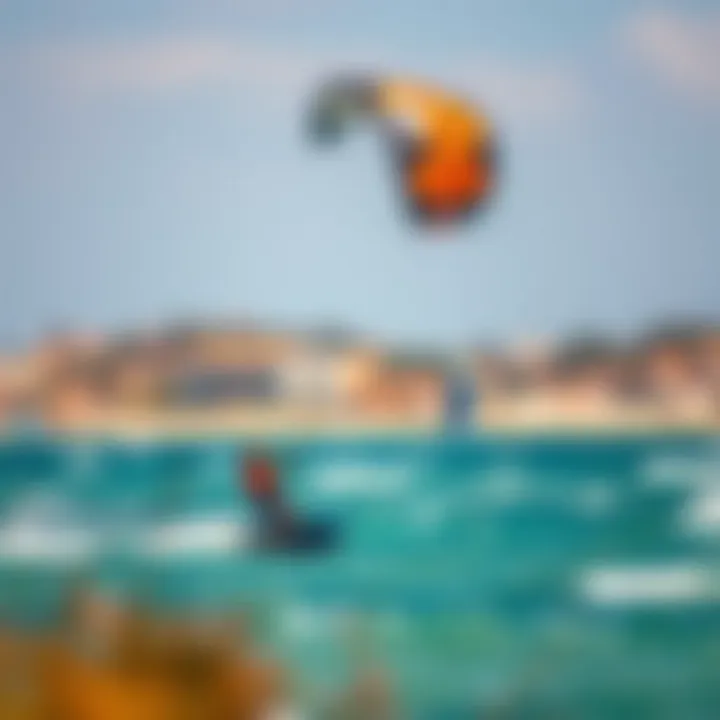
A solid grasp of emergency procedures should cover:
- Self-Rescue Techniques: Learn how to safely get back to shore if you find yourself in trouble, such as using your kite to float.
- Contacting Help: Have quick access to a phone or radio for emergencies.
Mastering these emergency procedures ensures that, should the unexpected occur, you can act swiftly and effectively, minimizing risks and enhancing your confidence in the sport.
Kite Maintenance and Care
Kite maintenance and care is often the unsung hero in the realm of kiteboarding. Without proper attention to your kite, the ride can turn from exhilarating to disastrous in the blink of an eye. This section delves into the significance of regular upkeep for both the longevity of your gear and your overall safety while kiteboarding. Regular care not only enhances performance but also safeguards your investment, ensuring it lasts through many adventures on the water.
Regular Checks and Repairs
Keeping a close eye on your kite is essential. Before each use, take a moment to perform routine inspections. Here are some aspects to consider:
- Visual Inspection: Check for any visible damage. Look for punctures, tears, or frayed edges. It’s crucial to address any issues before getting on the water.
- Bridle Lines: Make sure the bridle lines are not tangled or twisted. This can affect how the kite flies. If you find any kinks, gently untwist them, or replace the lines if needed.
- Inflation Check: Ensure your inflatable kite holds air properly. A slow leak might not be immediately noticeable but can turn a fine day into a hefty challenge on the water. A simple test is to inflate the kite fully and watch for any loss of pressure over time.
Repairs can be tricky, but many damages are manageable with some basic skills. Invest in a good repair kit, which usually includes patches, glue, and basic tools. If you’re unsure about a repair, consult with a professional. Remember, taking a proactive approach can mean the difference between a great day on the water and an unnecessary trip back to shore.
Proper Storage Techniques
Beyond the checks, how you store your kite also plays a pivotal role in its lifespan. Improper storage can lead to unnecessary wear and tear, making it crucial to adopt the right practices:
- Dry Before Storing: Always ensure your kite is dry before packing it away. Moisture can lead to mold and degrade the materials over time. If you’ve just come off the water, it’s worth taking the extra time to let it dry under the sun or in a well-ventilated area.
- Avoid Direct Sunlight: Prolonged exposure to the sun can fade colors and weaken the fabric. Use a protective cover or store it in a shaded area when not in use.
- Fold with Care: When packing your kite, fold it properly to avoid putting stress on seams and joints. Many brands provide guidelines on how to fold their kites efficiently.
"A stitch in time saves nine." Proper maintenance is a small time investment that pays enormous dividends in both performance and safety.
By implementing these maintenance routines and storage techniques, you not only extend the life of your kite but also enhance your overall kiteboarding experience. This attention to detail will keep your equipment in peak condition, ready for that next exhilarating ride on the waves.
Getting Started with Kiteboarding
Getting into kiteboarding can be both exhilarating and daunting for beginners. Grasping the core elements of this sport is crucial, as it sets the stage for a safe and enjoyable experience. Understanding how to effectively start your journey can dramatically impact your learning curve and help you avoid potential pitfalls.
A significant aspect of embarking on this kiteboarding adventure is finding appropriate training spots. This is vital because the environment in which you learn significantly influences your progress. Opting for a safe location with consistent winds can bolster your confidence and allow you to focus on mastering essential skills. Furthermore, it is equally important to choose a qualified instructor. The right mentor can provide tailored guidance and tips, ensuring that you develop the necessary techniques and safety practices from the get-go.
Getting a foothold in this sport also offers numerous benefits:
- Skill Development: Starting off with basic techniques ensures you build a strong foundation.
- Minimized Risks: Proper guidance and environment can help mitigate accidents.
- Community Involvement: Kiteboarding often fosters a sense of camaraderie among enthusiasts, making your journey more enjoyable.
The essence of beginning kiteboarding centers around being well-prepared and informed. With a solid plan, you can dive into this thrilling sport equipped with knowledge and confidence.
Finding a Training Spot
Selecting the right training spot can be the difference between a flourishing journey and a frustrating one. It’s not merely a matter of location but also about understanding specific elements that contribute to successful learning.
When scouting for a training spot, consider:
- Wind conditions: Ideal spots typically have consistent winds, which are neither too strong nor too weak. This helps you learn how to maneuver without feeling overwhelmed.
- Water depth: Shallow waters are safer for beginners, allowing for easier recovery should you fall, or if the kite crashes.
- Obstructions: Steer clear of areas littered with rocks, debris, or other watercraft. These can pose risks and make learning cumbersome.
In addition to physical attributes, the atmosphere matters too. Training in a location frequented by other kiteboarders often provides additional support and shared wisdom. It can also be comforting to learn in a lively space, as it tends to inspire motivation.
To sum it up, the optimal training spot is characterized by adequate wind, accessibility, safety from hazards, and a vibrant community. Always remember to check local regulations, as some areas may have restrictions on kiteboarding activities.
Choosing an Instructor
Taking the plunge into kiteboarding with the right instructor can make all the difference. A good instructor not only helps to navigate the complexities of kite control but also imbues a strong sense of safety and fun into the learning process.
Here are pointers to help you choose the right instructor:
- Certification: Look for instructors with recognized certifications from reputable organizations, as this indicates they have undergone the necessary training to teach.
- Experience: An instructor with a solid track record will not only have firsthand experience in various conditions but can also share valuable insights into common challenges and how to tackle them.
- Teaching Style: Everyone learns differently. Some learners thrive under a more hands-on approach, while others prefer a guided method. Engaging with an instructor who matches your style can enhance your learning experience considerably.
Don't hesitate to ask potential instructors about their methods, successes, and experiences. A good instructor will appreciate your curiosity and be glad to share.
Finding the right training spot and instructor for kiteboarding can underestimate your learning experience, so don't rush the process!
As you embark on your kiteboarding journey, always keep safety first and enjoy each moment on the water.
The End
The conclusion of this guide stands to fortify the invaluable insights shared regarding kiteboarding kites for newbies. It��’s more than just a summary — it ties together essential themes like safety, equipment care, and the exhilaration of the sport itself. Understanding what it means to embrace kiteboarding goes beyond merely selecting the right kite; it’s about cultivating a deeper connection to the elements — wind, water, and the very essence of adventure.
Embracing the Kiteboarding Journey
The journey into kiteboarding can feel like an exhilarating roller coaster, full of ups and downs, twists and turns. As a novice, it’s crucial to prioritize learning and practicing within safe environments. Seek training spots that are not just popular but are also friendly for beginners, away from crowded areas or tricky currents.
Choosing an instructor is just as important. A knowledgeable mentor can illuminate your path, helping you navigate through the initial learning curve. Their experience can offer you insights that books simply can't provide. Look for someone who holds certifications and has a solid reputation within the local kiteboarding community. Online platforms can be a good start to check ratings and reviews—don’t forget to ask around in local forums or at kiting events.
While the technical skills you gain are important, fostering a mindset that embraces learning and patience is essential. Kiteboarding isn’t an overnight achievement; it’s a gradual process filled with delightful discoveries. Each session on the water builds not only your skills but also your confidence. Stay curious, practice regularly, and take the time to savor the thrill of riding with the wind.
"The joy of set up and ride down the line is where the real magic of kiteboarding lies."
As you get comfortable with the nuances of kite control, the dynamics of the wind, and the rhythm of your body in sync with the kite, your experience will evolve decidedly. Further, consider engaging with local kiteboarding communities, whether online or offline. Sharing experiences with fellow enthusiasts will inspire you and may even unveil hidden tips that can significantly enhance your journey.















